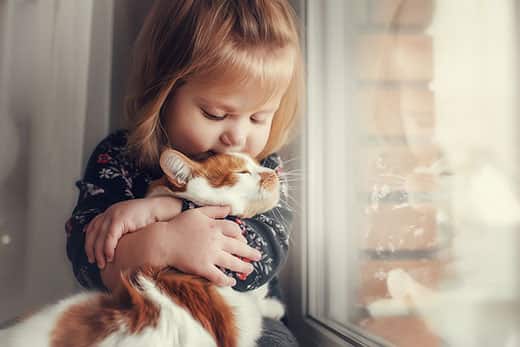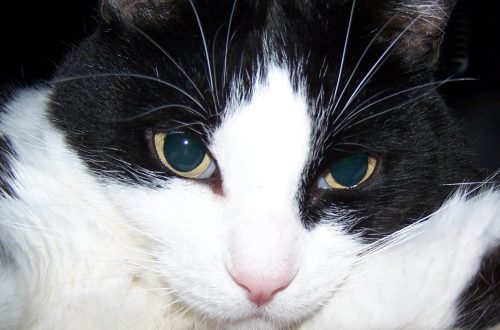
Cats that get along well with children: do they exist?
Do cats love children? Of course! And many are happy to play with the kids and sleep with them in an embrace. What is the best cat for a child?
Contents
Why do cats love small children?
Cats and small children can safely and happily get along with each other. But this is possible if you choose an animal with the right temperament. Gentle, friendly and patient pets become the best friends of kids. They say that cats are capricious, but many of them eventually become affectionate pets.
In addition, the presence of an animal in the house, such as a cat, can positively affect the development of the child. “Children who are raised with pets often show well-balanced traits that are indicative of emotional health, such as empathy, cognitive development, and more active participation in society,” says Cummings School of Veterinary Medicine at Tufts University.
Which cat to choose for a child
In order to find a pet that is best for the family, it is necessary to take into account the age and character of the children.
Shy cats do not fit well in families with young children. As International Cat Care explains, “Very nervous and timid cats will find it difficult to get along with children, so families with toddlers should avoid cats with this type of temperament.”
In such cases, the animal will often hide, and additional stress can lead to health problems, such as urinating outside the litter box. Instead, you should choose a cat that is not afraid of noise and will gladly join in the fun.
Although kittens are full of energy, they are unlikely to be the best option for families with babies and toddlers. Kittens, like owners, need a lot of physical activity. As the Humane Society of Friends of Animals explains, kittens can be frightened by the unpredictable behavior of a toddler who sees a cat as more of a soft toy than a living creature.
Both kittens and adult cats with energetic personalities are great for children aged four years and older, but not for children under three years old. Adult cats with an energetic temperament may not tolerate the antics of toddlers.
Choosing a cat for a child: important tips
Children should be included in the process of choosing a pet, starting by browsing the website and social media of the local shelter. However, before choosing a pet, visit the animal shelter with the whole family. It is important to see firsthand how the children and the cat react to each other.
It is necessary to ask the staff and volunteers of the shelter questions about the cats of interest. You can clarify the following facts about the pet:
- How does a cat get along with people?
- Is she outgoing or introverted?
- Has the cat interacted with children?
- Does she show signs of aggression or fear?
Then you need to describe the lifestyle of your family – calm and quiet, energetic and noisy, or something in between. So the shelter staff will help you choose the most suitable pet.
They will also ask a lot of questions – they will want to make sure that the family is suitable for one of their pets. After all, no one wants to end up in the awkward situation of having to return a cat to a shelter because it didn’t fit the family.
Which cat to choose for a child in an apartment
Here are some of the friendliest cat breeds that will suit a family with small children:
- American shorthair cat. The International Cat Association describes the American Shorthair as “one of the most adaptable breeds for any type of household” and “great with children.”
- Ragdoll. Known for their carefree nature, these plush cats love their owners and enjoy engaging in interactive play. They are extremely energetic, so they are more suitable for families with older children. In addition, they easily adapt to changes.
- Burmese cat. The breed is as affectionate and friendly as can be, as the Cat Fanciers Association confirms: “Due to their patient and even temperament, the Burmese makes an excellent choice for families with children and/or other pets.” An additional advantage of the Burmese is their soft quiet meow, which will not wake up a sleeping baby.
The described thoroughbred animals have characteristic features and a certain temperament, but a great friend can also be found in a local shelter. Even if the exact origin of the cat is unknown, this does not mean that it will not be possible to understand its character during visits to the shelter with the children.
The appearance of a cat in the house
A cat can be a wonderful pet for a family with children, but you still need to carefully prepare for its appearance in the house. It is very important to teach children how to communicate safely with a cat. You need to give the animal time to get used to the new environment. If your cat is insecure at first, you need to give him space, including a place where he can hide.
Adaptation to a new environment may not be entirely smooth and stressful for the animal. It is possible that when the cat gets home, she may develop indigestion or problems with urination.
In most cases, things will get better on their own when the pet begins to feel more comfortable in the new home. But if the difficulties of adaptation continue, it is necessary to limit the contact of the animal with children. Then you should give the cat time to slowly get to know the new family to ease the transition. If all else fails, you should contact your veterinarian to rule out health problems.
The time spent finding a cat that loves children will pay off handsomely. After her appearance in the house, relationships of love and strong affection will form between family members.
See also:
The XNUMX Friendliest Cat Breeds Safe Games for Cats and Kids You’ve Decided to Get a Cat: How to Prepare for One






